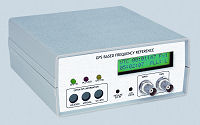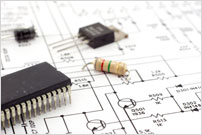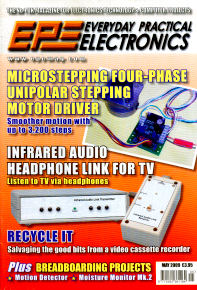May 2009 Issue
A summary of this month's contents.
Microstepping Four-Phase Unipolar Stepping Motor Driver

Stepping motors are used in many everyday applications and this month we present a high quality driver circuit that will provide smoother operation and more accurate control than ever before! Our microstepping motor driver provides up to 1/16th step operation, promising up to 3,200 steps for a standard 200 step motor. The design is based on SLA7062M stepper driver circuit that offers a more sophisticated degree of control whilst keeping complexity and size to the minimum.
A complete kit is available from Magenta Electronics
Infrared Audio Headphone Link for TV
 Do you have trouble hearing your TV properly and need the volume cranked up too loudly for anyone else? Now you can listen to your TV via headphones using this infrared optical link. Our cordless design means that you can turn up the sound level as much as you like, without disturbing anyone else, and there are no lengthy trailing wires to get in the way.
Do you have trouble hearing your TV properly and need the volume cranked up too loudly for anyone else? Now you can listen to your TV via headphones using this infrared optical link. Our cordless design means that you can turn up the sound level as much as you like, without disturbing anyone else, and there are no lengthy trailing wires to get in the way.
The two-unit design features an Infrared audio transmitter powered by a mains adaptor to drive no less than six IR emitters, and a battery-operated mono audio receiver with IR detector that converts the optical signal to drive a set of headphones. It has a range of about 5 metres and the hobbyist may find other applications for this design.
Our bumper constructional article describes the operation and construction in total detail, with all necessary drawings and photos to enable you to build this design with complete confidence.
Super Accurate GPS-Based Frequency Reference (Part 2)

This very high quality design uses a PIC 16F628A microcontroller to create a highly stable frequency reference that is linked to the Global Positioning System (GPS) satellite network. It utilises their highly accurate on-board caesium-beam 'atomic clocks' in conjunction with a Garmin GPS module to generate a clock signal. An onboard temperature-stabilised 'oven' uses a transistor as a heater to ensure stability.
Our GPS-based Frequency Reference drives a continuously updated LCD showing UTC time and date, GPS fix and PLL status. You can also read a short-term display of various navigational co-ordinates and basic satellite signal strength quality.
Part 2 of this project in the May 2009 issue describes the best way of constructing and adjusting the project, together with details of adding an RS-232C serial port to the unit. Free source code is available from our Library.
Breadboarding Projects (Part 8)

This series was specially written for beginners in electronics who are taking their first steps in project experimentation. Using a solderless 'breadboard' you can plug components together without the need to solder: remove or modify them and re-use them! No mains voltages are used and everything is powered from safe low-voltage batteries. This month a motion detector and a moisture monitor Mk 2 are described.
Also in this issue:
- PIC n MIX - Part 2 of Mike Hibbett’s series dedicated to Microchip PIC microcontrollers explores the challenge of using a PICmicro to generate video!
- TechnoTalk – regular EPE contributor Mark Nelson muses over the phenomenon of “disruptive technologies” and how young upstarts in technology manage to upset established marketplaces.
- Practically Speaking – Robert Penfold lends a helping hand in the electronics workshop, detailing the essentials of popular connector types.
- Circuit Surgery with Ian Bell – how to measure angular velocity and rotation electronically. Optical encoding, Gray-coded discs and more are described.
- Net Work – EPE’s Alan Winstanley goes online to hunt for a reputable Windows Registry Cleaner, and doesn’t always like what he finds.



